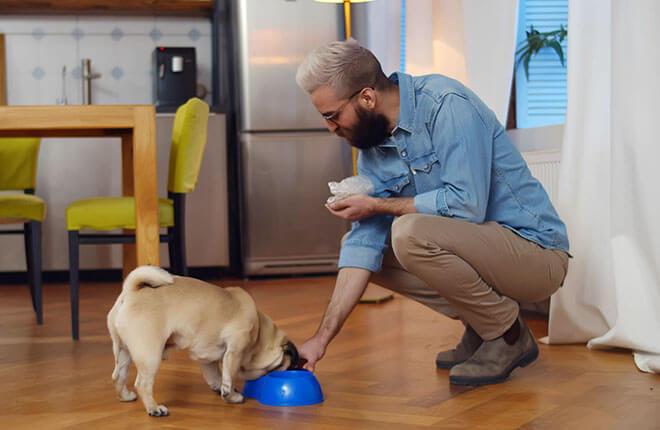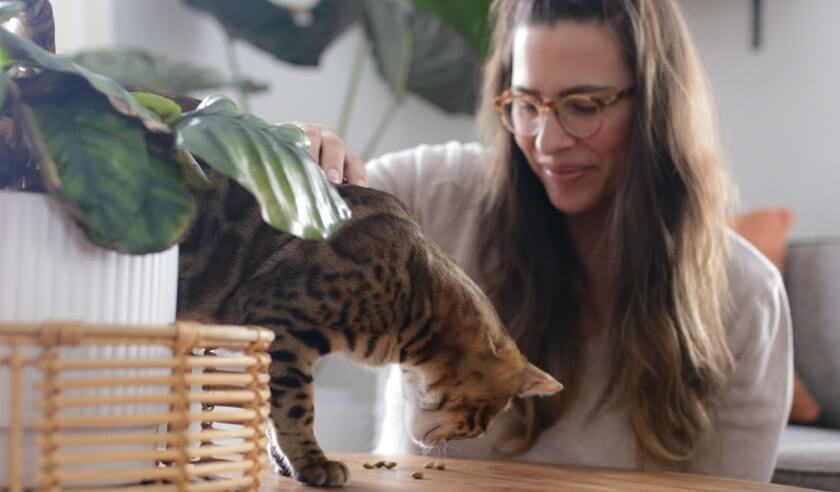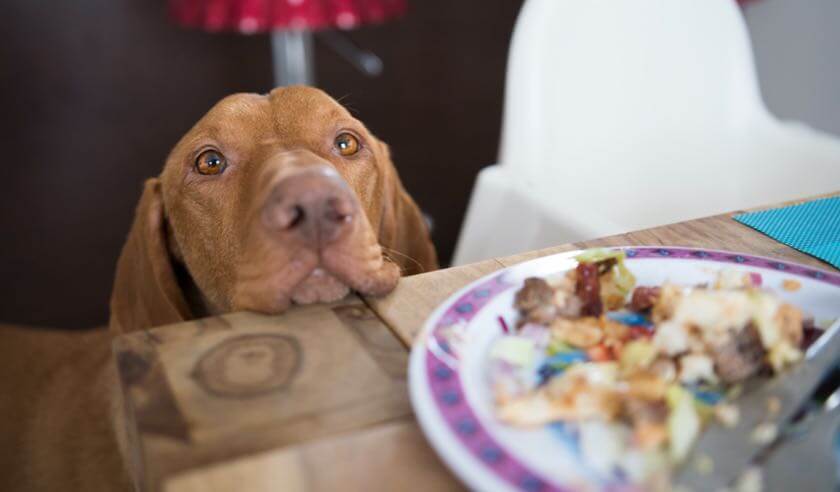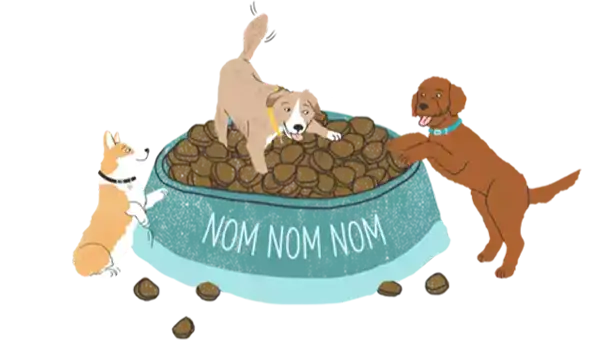Pets are getting bigger (or should we say wider?) — and it's not good news. In 2018, 60% of cats and 56% of dogs in the U.S. were overweight or obese[1]. With the overwhelming amount of information available on types of pet food, diets, and nutrition, it’s no wonder that many pet owners feel unsure about what and how much to feed their dogs and cats. Fortunately, with a little education and some help from your veterinarian, you can keep your pets happy and healthy by preventing overeating and obesity.
Signs You May Be Overfeeding Your Pet
There are some physical indicators you can use to help determine if your pet is overweight. One of the tools veterinarians use is called the Body Condition Score, which assesses your pet’s overall body appearance as an indication for the presence and location of fat. Check out the illustrations (don’t worry about the specific terminology) for dogs and cats from the World Small Animal Veterinary Association (WSAVA) to see what is considered ideal.

- Take a bird's eye view (see links above). Look at your dog or cat from above. They should have an hourglass figure, dipping in just behind the ribs and extending back to the hips.
- From the side (see links above). The area behind the ribs should look lifted.
- Feel around. When you run your hands over the rib cage, you should be able to feel the ribs. If your pet's waist is wider than their ribs or you can't feel their ribs, your pet likely needs to lose weight.
- See how they're getting around. Added weight causes inflammation and stress on the joints. If your pet is having a hard time running and jumping, or it takes more oomph to get up when they're lying down, they may be carrying extra weight. Getting to a normal weight can also make a big difference for some health conditions like osteoarthritis.
- Consult your veterinarian. Your best resource is your veterinarian. They can tell you if your pet is overweight and to what degree, as well as help you build a diet plan for maintaining or losing weight safely as needed.
The Risks of Overfeeding Your Pet
Just as we see in humans, obesity brings on numerous health issues for pets.
- Decreased longevity. One study revealed that an obese dog's lifespan is shortened by up to 2 ½ years compared to a dog that is a healthy body weight.[2]
- Inflammation. Inflammation also limits mobility and leads to issues like osteoarthritis in the joints and disc disease (like bulging or herniated discs) in the spine.
- Respiratory and cardiovascular problems. Difficulty breathing, high blood pressure, and increased risk of heart failure are associated with obesity. And any of these make anesthesia for surgical procedures more risky.
- Financial and emotional costs. If our pets are hurting, we're hurting. And diagnosing and treating the issues caused by excess body weight can leave your wallet hurting as well.
How Much Should You Feed Your Cat or Dog?
The best option is to consult with your veterinarian and determine your pet's ideal feeding and exercise program. While there are tools available online to help calculate how much pets should eat in general, every animal is an individual with their unique lifestyle, metabolism, and any underlying health issues — and all of these must be taken into account. Most pet food includes recommended daily feeding amounts on the packaging, but those recommendations aren't always reliable. Ask your veterinarian to provide you with a customized total of daily calorie needs for your pet and work with them to determine how it can be achieved.
How Many Treats Should You Feed Your Pet?
It's important to remember that your pet's total daily caloric intake goal includes all meals and treats. As a rule, treats should never make up more than 10% of the calories in your pet's diet.
A quick look at the back of three different treat bags shows why treats are a factor in overfeeding. A single treat in the first bag might be 15 calories, but 30 calories in the second bag. And a single treat (for example, a bully stick) from bag three could be 90 calories or more. If you have a 20-pound dog and your veterinarian recommends a total of 375 calories a day, you've already used up nearly 25% of your dog's total daily calories on just one (!) treat from bag number three.
Tips for Keeping Your Pet's Weight Under Control
There are some simple tips and tricks to managing your pet's weight and helping you avoid overfeeding.
- Use the correct tools. Get a set of dry measuring cups and pay attention to the fill lines on the inside of the cup. Some cups are designed to be larger than the actual measurement.
- Pre-measure. All meals and treats for the day can be measured out in advance. This makes it easier to only feed what has been allocated for each day, even when you're on-the-go or working on training where treats are part of the process.
- Pay attention. If you catch yourself being heavy-handed with treats during the day, cut back on the evening feeding or go on an extra-long walk.
- Look for low-calorie treats. Opt for low-calorie treats when possible. You can even try healthy human food (just be sure any human food treats you give are not toxic to your dog or cat) — ask your veterinarian for guidance.
- Cut or break treats into smaller pieces. That way, you can give three times the love with a single treat. It's the action of treating, not the size of the treat, that helps you connect with your pet.
- Get moving. Dogs and cats need exercise. Walks are great, but don't stop there. Using wand toys with your cat, creating an indoor obstacle course for your dog, or even just a good game of fetch burns calories.
Many of us owners have a tendency to overfeed our pets even though we don’t mean to. It can be tricky to understand how much to feed, how many treats to give, and how both contribute to total calories each day. But it's vitally important for the health of your pet and well worth the effort to pay attention to your pet’s caloric need and adjust your feeding plan to meet it without leading to extra pounds. Using the information above and working with your veterinarian to establish a diet and activity plan, you should be able to avoid overfeeding and keep your furry family members healthy and happy.
ZPC-01092R1
- 2018 Pet Obesity Survey Results: U.S. Pet Obesity Rates Plateau and Nutritional Confusion Grows. Pet Obesity Prevention. https://petobesityprevention.org/2018 Accessed February 16, 2021.
- Salt C, Morris PJ, Wilson D, et al. Association between life span and body condition in neutered client-owned dogs. J Vet Intern Med 2019;33:89-99.





